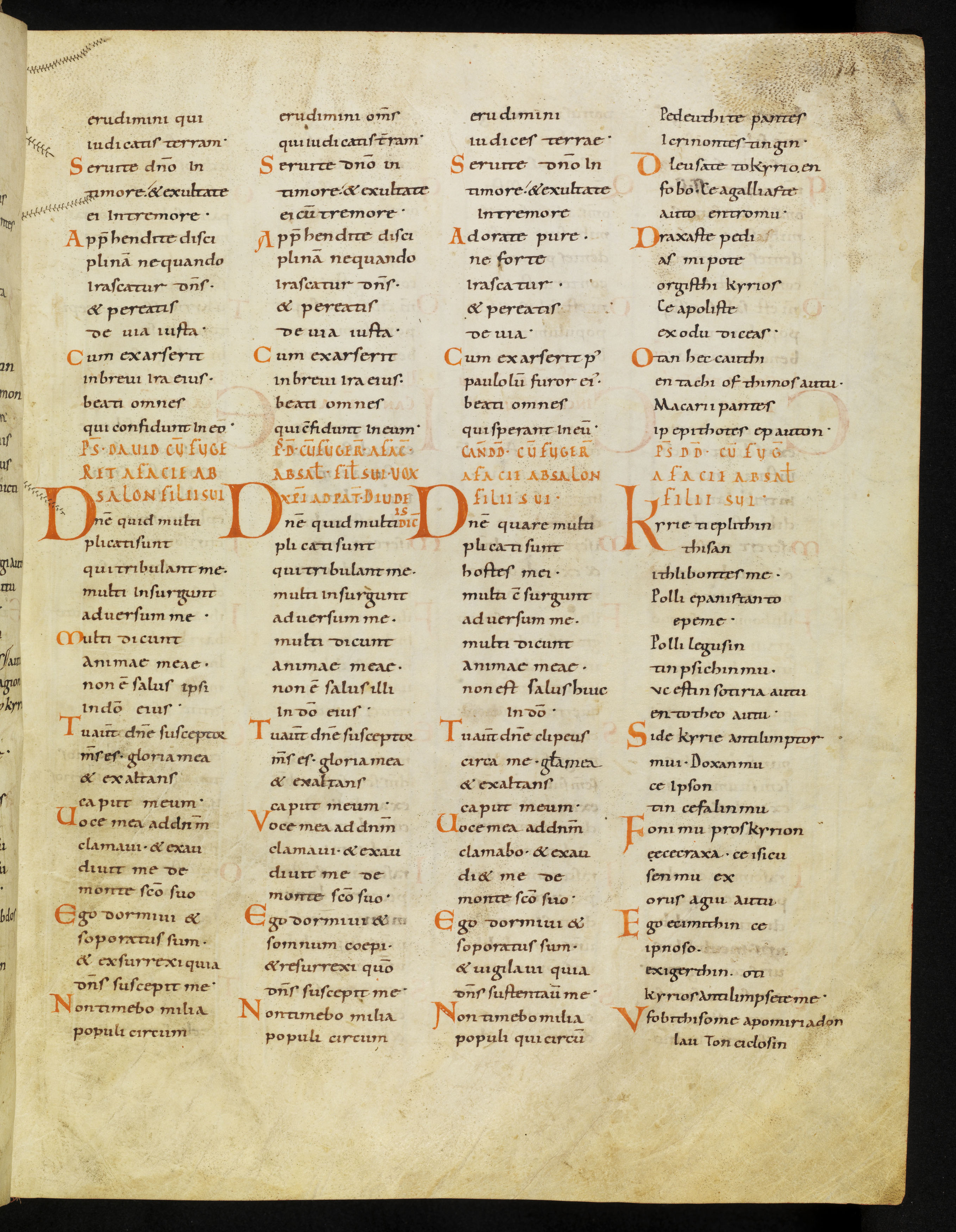
The Quadripartite Psalter Manuscripts
Maria Tomadaki
May 11, 2022
One of my duties in 2021 was the description of the so-called “quadripartite Psalter manuscripts” or “quadruplicia”, namely the Latin-Greek Psalters, which include four different versions of the Psalms and were mostly transmitted in the Latin West during the 10th–12th centuries. The earliest example of such a Psalter is the beautiful codex Bamberg, Staatsbibliothek, Bibl. 44, (Ra_1037). This manuscript was commissioned by Solomon III, abbot of the monastery of St. Gall in Switzerland and consists of four columns. The first three columns include the Latin versions of the Psalms by Jerome (“Psalterium Gallicanum, “Psalterium Romanum”, “Psalterium Hebraicum”), whereas the fourth column contains the Greek text of the Septuagint transliterated into Latin. Interestingly, the last folios of the Psalter transmit several prayers and hymns written in Latin and in Greek and they clearly demonstrate an interest in the Greek language. The Bamberg Psalter was highly influential and according to the chronicler, Ekkehard IV, it came later into the possession of Otto II (955–983). It is very likely that the manuscript attracted the attention of the German emperor due its Greek elements, since he was married to Theophano, the niece of the Byzantine emperor John Tzimiskes (ca. 924–976). Besides, it is well-known that Theophano was a dynamic woman, who inspired in the West an interest in the Byzantine art and language. More Psalters, with a similar format and content to the Bamberg one, were produced during the next two centuries. Their descriptions and more information related to the history of their production are available in our database.[i]
List of the Quadripartite Psalters
a) Entire Manuscripts
- Bamberg, Staatsbibliothek, Bibl. 44 (A I 14), (Ra_1037), date 909.
- Cologne, Dombibliothek Ms. 8, (Ra 1077), s. XI.
- Essen, Archiv der Münsterpfarre, Domschatz, Ms. 4, (Ra 1049), s. XI.
- Paris, Bibliothèque nationale de France, Nouvelles acquisitions latines 2195, (Ra 1143), date: 1105.
- Valenciennes (France), Bibliothèque municipale 14, (Ra 1210), s. XII.
- Graz, Universität Graz, UBG Ms. 86, (Ra 1268), s. XII.
b) Fragments
- Vatican, Biblioteca Apostolica Vaticana, Pal. lat. 39, Fragm. ff. 43r–43v (Ra 8002), s. XI.
- Düsseldorf, Universitäts-und Landesbibliothek, Fragment K 16: Z1/2a, (Ra 8003), s. XI.
- Bamberg, Staatsarchiv A 246, Nr. 20 I, Nr. 20 II, Nr. 20 III and Freiburg im Breisgau,
- Universitätsbibliothek, MS. 629, (Ra 8004), s. XII.
- Coburg, Staatsarchiv, Fragmentensammlung Nr. 2.40–2.44, (Ra 8005), s. XII.
- Leipzig, Universitätsbibliothek Leipzig, Ms 1610, ff. 19v–20r (Ra 8006), s. XII.
- Fragment from the Bible Collection of Dr. Charles Caldwell Ryrie, Beinecke Rare Book and Manuscript Library (Ra 8007), s. XII.
All of the above manuscripts and fragments have been previously recorded by Walter Berschin and Jürgen Erdmann, apart from the last two fragments, which I was able to trace recently on internet thanks to their digitization by the Manuscripta Medievalia and the Sotheby’s Manuscript Department.[ii] The content and the relation of all the fragments were identified after a careful examination of their digital images.[iii] In addition, new Rahlfs numbers (Ra) had to be assigned to all the fragments and to the manuscript from Graz, since these witnesses were not known to Alfred Rahlfs at the time when he was preparing his vast catalogue of the biblical manuscripts.[iv] Without doubt, the quadripartite Psalters fascinate the Modern reader with their elegant presentation of Jerome’s Psalter versions, as well as with their Greek elements, which offer an insight into the reception of the Greek language in the Medieval West.
Cod. Bamberg, Staatsbibliothek, Bibl. 44, (Ra_1037), f. 13r
[i] The interesting history of the quadripartite Psalters’ transmission, their affinities and their relation to the Ottonian dynasty are analyzed in a forthcoming article.
[ii] See W. Berschin, “Salomons III. Psalterium quadrupartitum in Köln und Heidelberg. Mit Anhang: Die Bamberg / Coburg / Freiburger Fragmente eines Psalterium quadrupartitum”, in Kaiserin Theophanu: Begegnung des Ostens und Westens um die Wende des ersten Jahrtausends: Gedenkschrift des Kölner Schnütgen-Museums zum 1000. Todesjahr der Kaiserin /herausgegeben von A. von Euw und P. Schreiner, Volume 1, Köln 1991, pp. 327-334, W. Berschin, “Neun Psalteria quadrupartita Salomons III. von Konstanz (Abt von St. Gallen 890-920)” in id. (ed.), Mittellateinische Studien, Heidelberg 2005, pp. 203-214, and J. Erdmann, “Coburger und Bamberger Fragmente eines Psalterium Quadrupartitum”, Bericht des Historischen Vereins Bamberg 102 (1966), pp. 63–80.
[iii] I am grateful to Johannes Staudenmaier, Birgit Hufnagel and Sarah Schneider for sending me digital images of the fragments from Bamberg, Coburg and Freiburg.
[iv] See A. Rahlfs, Verzeichnis der griechischen Handschriften des Alten Testaments (Mitteilungen des Septuaginta-Unternehmens der königlichen Gesellschaft der Wissenschaften zu Göttingen 2), Berlin 1914.
by Bonifatia Gesche, December 23, 2025
by Matteo Domenico Varca, November 30, 2025
by Anna Kharanauli, October 31, 2025
by Jonathan Groß, September 26, 2025
by Felix Albrecht, August 31, 2025
by Vadim Wittkowsky, July 31, 2025
by Bradley Marsh, June 30, 2025
